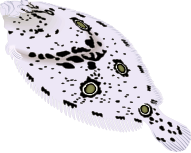GLOSSA
Research Directions:
Reproduction and physiology
Production technologies
Description:
 Marine fish farming in Europe in mostly restricted to a few species, such as the European sea bass (Dicentrarchus labrax), gilthead seabream (Sparus aurata) and, to a much lesser extend turbot (Scophthalmus maximus). As a result, selling prices have been severely reduced, at times reaching below the cost of production. It has been long recognized, that diversification of the aquaculture production is imperative for the improvement of the economics of the industry, and the utilization of niche markets and production possibilities. One of the main candidates as a new species for aquaculture, especially in Spain, is the sole (Solea senegalensis). Although many farms have shown interest in culturing sole, and attempts have been made in producing larvae in commercial hatcheries, culture trials of sole have shown serious problems related to its reproduction in captivity. When spawning is achieved, the females produce irregular and unpredictable spawning, consisting of a few eggs with variable quality, whereas the males produce very little and viscous milt, which reduces its fertilization ability. These problems prevent a consistent supply of good quality seed and thus, the development of a profitable and sustainable aquaculture industry for sole.
Marine fish farming in Europe in mostly restricted to a few species, such as the European sea bass (Dicentrarchus labrax), gilthead seabream (Sparus aurata) and, to a much lesser extend turbot (Scophthalmus maximus). As a result, selling prices have been severely reduced, at times reaching below the cost of production. It has been long recognized, that diversification of the aquaculture production is imperative for the improvement of the economics of the industry, and the utilization of niche markets and production possibilities. One of the main candidates as a new species for aquaculture, especially in Spain, is the sole (Solea senegalensis). Although many farms have shown interest in culturing sole, and attempts have been made in producing larvae in commercial hatcheries, culture trials of sole have shown serious problems related to its reproduction in captivity. When spawning is achieved, the females produce irregular and unpredictable spawning, consisting of a few eggs with variable quality, whereas the males produce very little and viscous milt, which reduces its fertilization ability. These problems prevent a consistent supply of good quality seed and thus, the development of a profitable and sustainable aquaculture industry for sole.
Failure of female broodfish to undergo final oocyte maturation (FOM) and spawning, and reduced spermiation in males in captivity is a common reproductive dysfunction of cultured fishes. This is due to the absence of the appropriate spawning environment, as well as the stressors imposed by captivity. Manipulation of reproductive processes and induction of FOM and spermiation can be achieved using a variety of hormonal treatments. We believe that adequate broodstock management and the application of modern hormonal therapies will greatly reduce these reproductive dysfunctions, as it has been done in the European sea bass (Dicentrarchus labrax) dusky grouper (Epinephelus marginatus), turbot (Scophthalmus maximus) and greater amberjack (Seriola dumerili). In the case of sole, there is a handicap on the little scientific knowledge available on its reproductive processes and limited expertise on its reproduction in captivity, which has focused mostly on the common sole (Solea solea). The use of gonadotropin-releasing hormone agonist (GnRHa)-based hormonal treatments has demonstrated its efficacy to induce spawning and synchronize the broodstock in several cultured fish species. Treatment with GnRHa can be done in the form of simple injections or sustained-release delivery systems. Due to the short half-life of GnRHa, a simple injection induces a brief elevation in plasma luteinizing hormone (LH), the gonadotropin responsible for FOM. As a result, some fishes require multiple GnRHa injections for an effective treatment, whereas in some occasions the required handling for multiple injections is prohibitive, both for management and fish welfare reasons. Sustained-release GnRHa-delivery systems (implants or microspheres), on the other hand, induce long-term stimulation of LH release with only a single treatment, and have proven effective in inducing FOM, spermiation and spawning in many fishes. Studies over the past decade have demonstrated that these new therapies are specially appropriated for species with repetitive spawning (i.e. asynchronous ovarian development), such as the sole. The aim of the present project is the study and description of the reproductive cycle of sole, and the development and application of novel hormonal therapies, for the control and stimulation of spermiation in males and egg deposition in females. This is the first time that this type of hormonal induction methods will be applied in sole.


